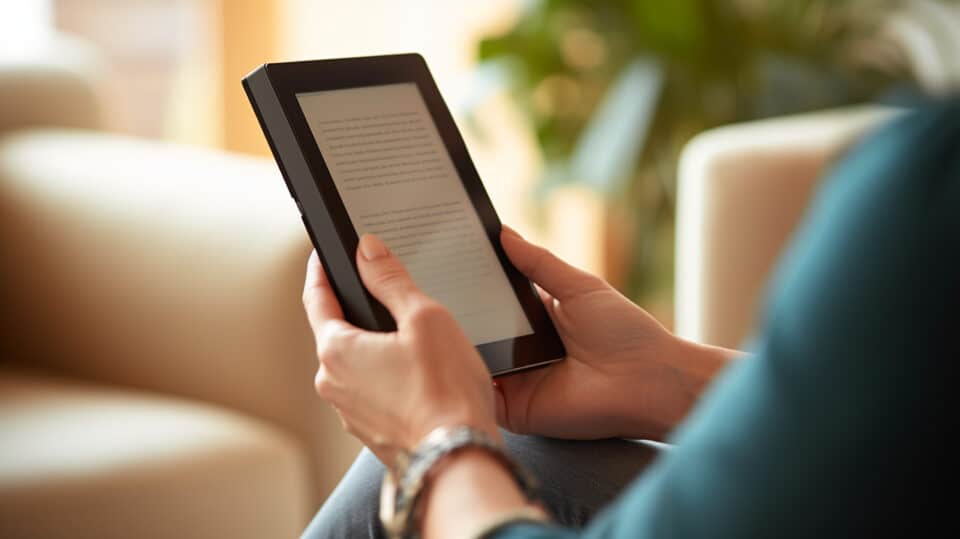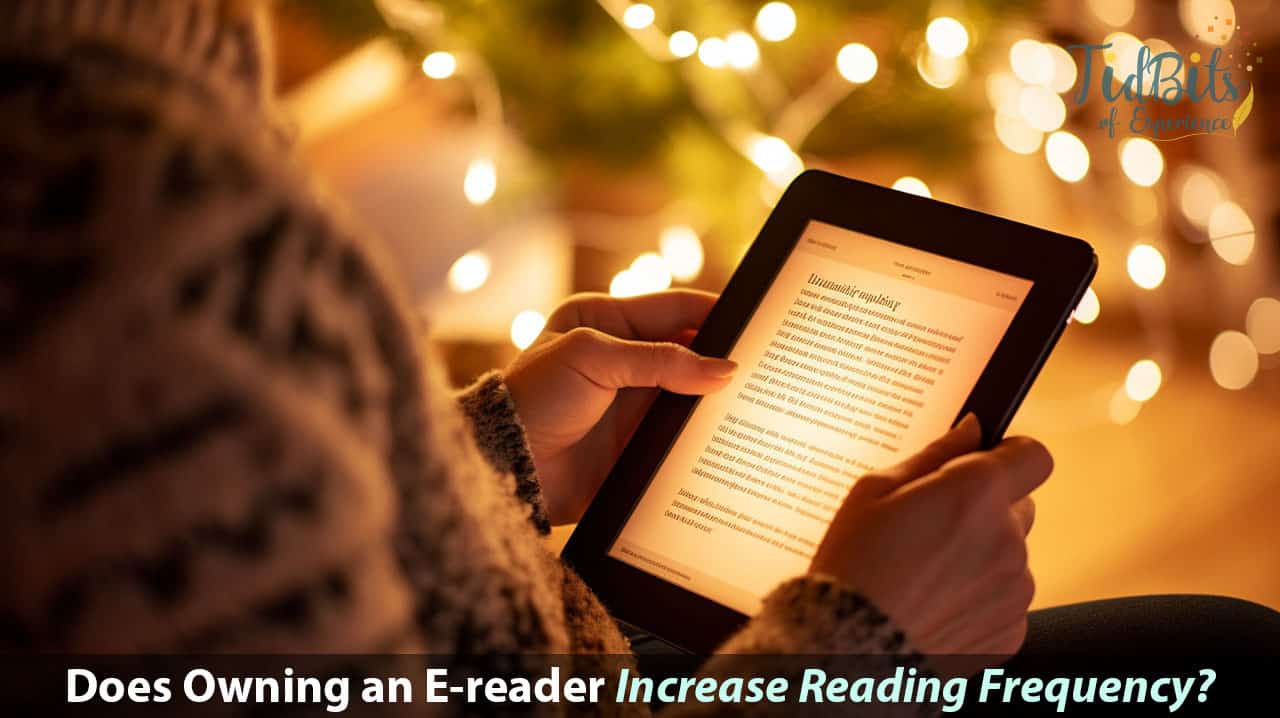Navigating the world of reading often poses a challenging question: do e-readers encourage more frequent reading, or does the traditional paper book still reign supreme? I’ve found myself pondering this very question, armed with studies showing that comprehension can take longer when using an e-reader.
This blog dives deep into understanding how e-readers impact our reading habits and questions whether they truly foster a love for literature. So, are you ready to explore the relationship between e-readers and our reading routines?
Key Takeaways
Ereaders offer unique opportunities for interaction and connection with other readers, adding an audience to the reading experience.
Preferences between ebooks and print books vary based on age, education, and income demographics.
Print books continue to outsell ebooks in the US market, but ebook sales have been steadily growing since 2015.
The cost implication of choosing between ebooks and printed books depends on factors such as budget, storage space, and personal preferences.
Table of Contents
Understanding Ereaders: What are they?

Ereaders are digital devices designed especially for reading electronic books and periodicals. You’re likely familiar with popular versions like Amazon’s Kindle reader, Barnes & Noble Nook, or Apple Books.
These gadgets often feature e-ink technology that mimics the look of printed text on paper to reduce eye strain in digital reading.
Interestingly, Ereaders aren’t limited to dedicated ebook readers only; tablets such as the Android Kindle Fire can also function as an e-reader. They support different file formats, including EPUB format for eBooks and AZW eBook format specific to Kindle readers.
What makes them stand out from physical books is their ability to store thousands of titles in one place, along with features like adjustable font size, which can aid those with learning impairments or disabilities like dyslexia.
The Impact of Ereaders on Reading Habits

Ereaders have profoundly influenced reading habits, changing perceptions and accessibility while expanding the audience for books.
Perceptions and Understanding
The way we perceive and understand text definitely impacts our choice between e-readers and print books. For instance, those who find great comfort in the tactile aspects of reading, from physically turning a page to feeling a book’s weight in their hands, often swear by print books.
Conversely, tech-savvy readers might be drawn towards the portability and accessibility of ebooks that an e-reader provides. Factors such as eye strain with digital reading or the serendipity associated with traditional books influence these perceptions too.
Yet it’s not all about personal preference or convenience; there is also evidence suggesting that comprehension can differ depending on the format. According to The Scientific American, mental navigation through text can be more challenging while reading online due to the lack of spatiotemporal markers often found in physical books.
Usability and Accessibility
E-readers truly shine when it comes to usability and accessibility. They make reading possible for those with visual impairments, as they can adjust the font size to suit their needs.
Customization options extend beyond just font adjustments; there are settings to change background colors, text spacing, or even convert text into speech. These features are especially beneficial for individuals who struggle with dyslexia or other learning impairments.
Modern e-readers are designed keeping user-friendliness in mind. They’re lightweight and portable – carrying a whole library around has never been easier! The touch-screen interface is intuitive and easy to navigate; you won’t need a manual to get started on your Kindle reader.
Additionally, some models come equipped with built-in lighting systems that reduce eye strain in digital reading – practical for both day and night-time indulgence!
Adding an Audience
As an avid reader, I have always believed that books have the power to transport us to different worlds and open our minds to new ideas. But with the rise of e-readers, it seems like reading habits are evolving.
One interesting aspect of e-readers is their ability to add an audience to our reading experience. Whether through social features or online book clubs, e-readers provide opportunities for readers to connect with others who share their love for literature.
Research has shown that discussing books with others can enhance our understanding and enjoyment of the story. In fact, a study found that participants who engaged in discussions about a book had better comprehension compared to those who read alone.
Ereaders make it easier than ever before to find fellow readers and engage in thoughtful conversations about the books we love.
Another way e-readers add an audience is through digital sharing options. With just a few taps on the screen, we can recommend books or share quotes on social media platforms, connecting with friends and even strangers who may be interested in our literary discoveries.
Analysis of Reading Statistics: Ebooks vs Printed Books

Let’s dive into the fascinating world of reading statistics and compare the popularity and sales of ebooks versus printed books. The data may surprise you and might just encourage you to read more, regardless of your preferred format.
So keep on reading to discover the evolving landscape of book consumption!
Popularity Contest: Ebooks Versus Print Books
Alright, let’s get into the heat of the battle between ebooks and print books. Both have their own loyal fan base, and each format has its own advantages and disadvantages. Here’s a little table to sum it up for you:
| Ebooks | Print Books | |
| Advantages | Ebooks are more convenient to carry and store. They generally cost less than print books, especially since Ereaders gained the ability to set their own prices in 2015. They can also be downloaded instantly. | Print books provide a physical reading experience. Many readers find it more satisfying to turn a real page than to swipe a screen. Some books are cheaper in print than in digital format. Plus, print books can be resold or lent. |
| Disadvantages | Ebook reading requires a device that can be expensive, like an Ereader or a tablet. There can be compatibility issues between different Ereaders and ebook formats. | Print books are bulkier and heavier to carry around. They can be more expensive than ebooks, although the price can vary. |
The choice between ebooks and print books often comes down to personal preference. But there’s no denying that the convenience and lower price of ebooks make them an attractive option for many readers. As for me, I’m a fan of both. I love the convenience of ebooks, but there’s something special about holding a physical book in my hands. What about you, ladies? Do you prefer ebooks or print books?
Demographics: Reader vs E-Reader
As a woman who appreciates a good book, you might be curious about the demographics of who prefers what when it comes to reading formats. Particularly, it’s intriguing to see how preferences between traditional books and e-readers vary among different groups.
| Demographic Group | Print Books | E-Readers |
| Age 18-29 | 68% | 32% |
| Age 30 and above | Most individuals prefer print books | Lesser individuals prefer e-readers |
| Education Level: High School Graduates | 61% | 39% |
| Education Level: College Graduates | 10% | 90% |
| Income Level: Above $75,000 per annum | 14% | 86% |
The table above gives a snapshot of how preferences vary based on age, education, and income. It’s clear that a significant number of older adults and some high-income individuals lean towards e-readers. On the other hand, print books still hold a unique charm for many, particularly among younger demographics. As an older woman, it’s good to know where your reading preferences align in the bigger picture.
Print and Ebook Sales in the US
It’s quite fascinating to examine the sales of print books and eBooks in the U.S. market. The numbers tell us quite a story about reading habits and preferences.
| Year | Print Book Sales (in million units) | Ebook Sales (in million units) |
| 2020 | 688.7 | 191 |
| 2022 | 788.7 | N/A |
Despite the growing popularity of e-readers, print books continue to reign supreme in the U.S., with a 13.2% increase in sales from 2020 to 2022, leading to 788.7 million units sold. A fascinating fact is that print books outsell eBooks by a ratio of 4 to 1. Although the sales numbers for eBooks in 2022 are not available yet, it’s worth noting that in 2020, 191 million eBooks were sold in the country.
It’s not all doom and gloom for eBooks, though. With the dawn of 2023, the U.S. reported a 3.7% growth in eBook sales in January compared to the same month in 2022. This resulted in $85 million in revenue, indicating a steady growth since 2015.
Regardless of the format, the love for reading in the U.S. remains robust and shows no signs of dwindling. Whether you’re a fan of the traditional print book or love the convenience of eBooks, there’s a book out there for everyone.
The Cost Implication: Ebooks vs. Printed Books

When it comes to affordability, the fight between ebooks and printed books is close. The cost of both types largely depends on multiple factors. Let’s dive into the specifics.
| Ebooks | Printed Books |
| In most cases, ebooks are less expensive than printed books. A report shows that between 2021 and 2023, the average price gap between ebooks and hardcovers on Amazon increased by 75% in favor of ebooks. Therefore, if you’re budget-conscious, ebooks can be a better option. | Printed books, especially hardcovers, can be pricier. For example, in January 2023, the cost of printed books was consistently higher than ebooks. Also, when we consider the long-term cost of buying and storing physical books, it can add up quickly. However, for those who cherish the feel of a physical book, the cost might outweigh the benefit. |
| Ebooks also have frequent sales and discounts, especially on platforms like Amazon’s Kindle, which holds a substantial 72% share of the e-reader market. | It’s also worth noting that printed books on sale can sometimes be cheaper than ebooks. Plus, there’s always the option of buying used books or swapping books with other readers. |
| Another cost-related benefit is the potential for unlimited storage. With an e-reader, you can have an entire library in your hand without worrying about physical space. | This is something that isn’t possible with printed books. If you’re an avid reader, the physical space required to store books could be a potential issue. |
In conclusion, the cost implication of choosing between ebooks and printed books greatly depends on personal preferences, such as budget, storage space, and access to sales and discounts.
The Convenience Factor: Ereaders vs Traditional Books

Ereaders offer practicality and ease of use, making it convenient for people to carry multiple books in a single device while also raising concerns about eye health from prolonged digital reading.
Practicality of E-readers
Ereaders offer a practical solution for avid readers who want to carry multiple books with them wherever they go. With an e-reader, you can have your entire library at your fingertips, eliminating the need to lug around heavy printed books.
Additionally, e-readers are lightweight and compact, making them easy to slip into a purse or backpack. They also allow for adjustable font sizes and backlighting options, ensuring a comfortable reading experience in any lighting condition.
So whether you’re commuting on public transportation or embarking on a long journey, the practicality of e-readers makes it convenient to indulge in your favorite stories without the hassle of carrying physical books.
The Impact on Eye Health
Reading on screens, such as e-readers, can have an impact on eye health. The exposure to blue light emitted by these devices has been found to cause eye strain and disrupt sleep. This is because blue light can affect our natural circadian rhythm, making it harder for us to fall asleep at night.
In contrast, print books do not emit blue light and therefore do not cause the same eye strain or sleep disturbances. So if you’re concerned about your eye health, consider opting for a good old-fashioned print book instead of using an e-reader before bedtime.
Reading on Mobile Devices
Reading on mobile devices has become increasingly popular in today’s digital age. With the convenience of smartphones and tablets, more and more people are turning to these devices as their primary means of reading.
However, research studies have shown that reading on screens can have an impact on our comprehension and retention abilities. In fact, studies have found that people read slower, less accurately, and less comprehensively when reading on screens compared to reading on paper.
Children also seem to have a preference for print books and tend to pay more attention to them than ebooks. Additionally, adults who read a mystery in paper form actually had better retention of the story compared to those who read it on Kindle.
The Future of Reading: Print Books, Ebooks, and Audiobooks

In the ever-evolving world of technology, the future of reading holds immense possibilities. From the traditional printed book to the convenience of e-books and the rising popularity of audiobooks, there is a format for every reader.
As we embrace these advancements, let us not forget to nurture our love for words and stories by exploring different mediums and embracing new experiences. So go ahead, grab a printed book or switch on your e-reader or audio device – let’s dive into the vast world of literature together!
Future of Printed Books
The future of printed books is a topic that sparks both curiosity and concern. As technology continues to advance, it’s natural to wonder if traditional print books will become obsolete.
However, despite the rise in e-readers and digital reading platforms, printed books still hold a special place in our hearts. In fact, studies show that 67 percent of Americans have read a paperback book in the past year.
Print books offer a tangible experience that cannot be replicated by their digital counterparts. They provide a sense of nostalgia, allowing us to connect with the written word on a deeper level.
Future of the Ebook and E-Reader
The future of the ebook and e-reader is bright. As technology continues to advance, we can expect more innovations in the world of digital reading. Ebooks offer a convenient and portable way to carry an entire library with you wherever you go.
With improvements in accessibility features, ebooks can be enjoyed by individuals with learning impairments or disabilities such as dyslexia. Additionally, the rise of audiobooks has expanded reading options for those who prefer to listen rather than read.
So whether you’re a fan of traditional books or embrace the digital age, there’s no denying that ebooks and e-readers are here to stay.
The Rise of Audiobooks
I’ve noticed a fascinating trend in the world of reading: the rise of audiobooks. More and more people are gravitating toward this format, and it’s easy to see why. Audiobooks offer a unique and immersive experience that allows you to enjoy books while on the go or engaged in other activities.
In fact, according to The Scientific American, audiobook sales have been steadily increasing over the years, with millions of titles available for listeners across various genres. This surge in popularity suggests that audiobooks may very well be shaping the future of reading as we know it.
With their convenience and accessibility, it’s no wonder why women (and readers in general) are embracing this new way of experiencing stories and ideas without compromising their busy lifestyles.
Frequently Asked Questions About E-Readers
Do people with e-readers read more compared to those without?
The relationship between owning an e-reader and reading habits is complex. While some studies suggest that people with e-readers do tend to read more, it ultimately depends on the individual’s personal preferences and habits.
What are the advantages of using an e-reader for reading?
Ereaders offer several advantages for reading, such as portability, access to a wide range of ebooks in one device, adjustable font sizes for comfortable reading, built-in dictionaries and highlighting functions, and the ability to carry multiple books at once without the added weight.
Are there any disadvantages to using an e-reader for reading?
Some potential disadvantages of using an e-reader include eye strain from prolonged screen time, battery life limitations requiring frequent charging, potential distractions from other apps or notifications on the device, and a lack of physical book experience for those who prefer the tactile feel of traditional books.
Can owning an e-reader improve someone’s overall reading habits?
While owning an e-reader may provide convenience and accessibility to a larger volume of books, it ultimately depends on the individual’s motivation and commitment to reading. An e-reader can be a useful tool in developing consistent reading habits by eliminating barriers like limited access or physical book storage concerns.
Conclusion: Do People with E-readers Read More?
In conclusion, while e-readers have certainly made reading more convenient and accessible, there is no definitive evidence to suggest that people with e-readers read more than those who prefer traditional books.
The impact of e-readers on reading habits is complex and multifaceted, influenced by factors such as personal preferences, demographics, and the overall reading experience. Ultimately, whether someone reads more or less depends on individual habits and motivations rather than the format in which they choose to consume their books.
